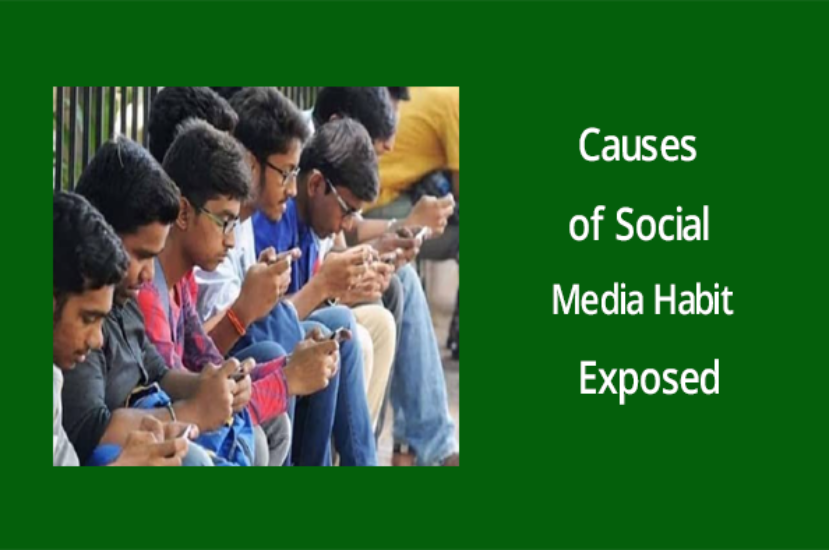Social media exposure is an addiction that is driving our youth towards destruction. This is why it is imperative to educate our youth about the reasons behind social media habits. So I have tried to write in detail the reasons for revealing social media habits.
We need to lead our youth to the path of light and take them away from their addiction to social media. Because this addiction is more dangerous than drugs. Below is a phased discussion of the reasons behind social media habits-
Causes of Social Media Habit Exposed
Introduction:
In the advanced age, the inescapable impact of social media has gotten to be both a boon and a bane. Whereas these stages offer a phenomenal network, a disturbing drift has developed – social media habit. This SEO-friendly article dives into the basic causes of social media enslavement, shedding light on the mental, social, and innovative components that contribute to this developing concern.
The Dopamine Dilemma:
At the center of social media compulsion lies the neurotransmitter dopamine. Each notice, like, or comment triggers a dopamine discharge within the brain, making a pleasurable sensation. This neurological remunerate framework keeps clients interminably locked in, looking for another computerized certification. The addictive cycle of expectation and compensation contributes essentially to the compulsive utilization of social media platforms.
FOMO and Social Comparison:
The fear of missing out (FOMO) may be an effective mental inspiration that impels social media habits. Consistent presentation of curated and frequently idealized forms of others’ lives cultivates a sense of insufficiency and the fear that others are encountering more fulfilling lives. Social comparison gets to be a driving constraint, compelling people to remain associated to maintain a strategic distance from feeling cleared out out.
Algorithmic Manipulation:
Social media stages utilize advanced calculations planned to maximize client engagement. These calculations analyze client behavior and inclinations, conveying personalized substance custom-made to the person interface. Whereas useful, this customization can make reverberate chambers, fortifying existing convictions and inclinations and catching clients in a cycle of steady consumption.
Social Approval and Self-Esteem:
The journey for social approval may be a noteworthy cause of social media enslavement. Measurements such as likes, offers, and devotees get to be a degree of one’s social worth. Clients may discover themselves caught in a cycle of looking for outside approval to reinforce self-esteem, driving to compulsive posting, checking notices, and measuring self-worth through advanced measurements.
Elude and Adapting Mechanism:
Social media frequently serves as an elude to real-world stressors. The quick satisfaction and diversion given by these stages can end up being an adapting instrument for people managing uneasiness, forlornness, or boredom. The ease of getting to an advanced world is an appealing elective for confronting challenging feelings.
Interminable Scroll and Perpetual Content:
The plan of social media stages, especially the interminable scroll, contributes to habit. The persistent stream of substance makes an environment where clients discover it challenging to separate. The nonattendance of normal ceasing focuses empowers delayed utilization, cultivating a sense of immortality that can lead to over-the-top screen time.
Peer Weight and Social Influence:
Social media enslavement frequently comes about from peer weight and social impact. They want to comply with social standards and be a portion of online communities that drive people to stay always associated. The fear of losing out on patterns, discourses, or shared encounters can make an overwhelming drag towards maintained engagement.
Gaming and Gamification:
Many social media stages join gamification components, turning engagement into a diversion with rewards and accomplishments. Highlights like streaks, identifications, and virtual rewards incentivize clients to keep utilizing the stage frequently. This gamified structure intensifies the addictive nature of social media, turning it into a habit-forming experience.
Need for Direction and Accountability:
The relative need for direction and responsibility in social media stages contributes to enslavement. Not at all like conventional media, these stages work in a computerized Wild West with negligible oversight. This need for control permits the expansion of addictive plan designs and the unchecked spread of hurtful content.
Personalization Algorithms:
While personalization calculations upgrade client involvement, they contribute to compulsion. By continually refining substance based on client behavior, these calculations make a curated computerized environment that adjusts to personal inclinations. The result is an addictive circle where clients are ceaselessly served substance that adjusts with their existing worldview, constraining introduction to different viewpoints.
Conclusion:
The causes of social media enslavement are multifaceted, interweaving mental, social, and mechanical components. Recognizing these components is the primary step in tending to the developing concerns encompassing intemperate social media utilization. Striking an adjustment between the benefits of the network and the potential pitfalls of compulsion requires a collective exertion from clients, stage designers, and policymakers alike. By cultivating mindfulness and encouraging careful utilization, able to navigate the computerized scene more deliberately and relieves the antagonistic impacts of social media habits.




Leave a comment